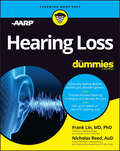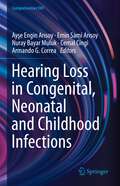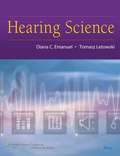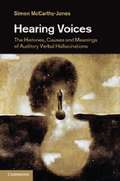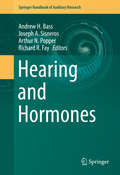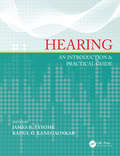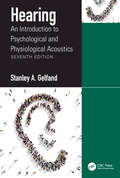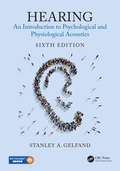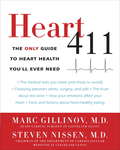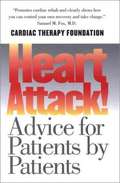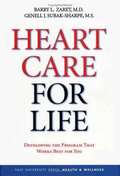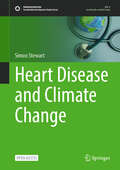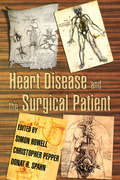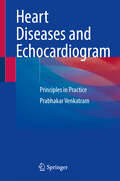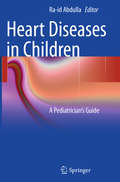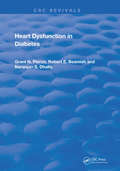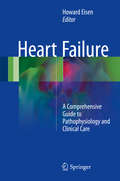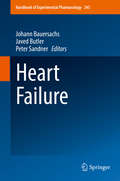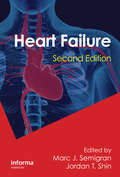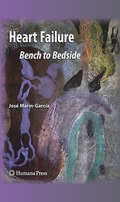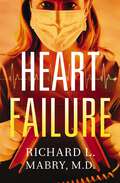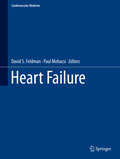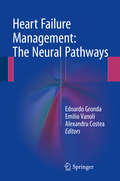- Table View
- List View
Hearing Loss For Dummies
by Nicholas Reed Frank LinImprove your hearing, enhance your life With new advice on just-released over-the-counter hearing aids Hearing loss can be frustrating, but in fact it&’s common and treatable. Hearing Loss For Dummies, written by top experts in the field in collaboration with AARP, walks you through how to get the help you need to clearly hear the sounds of life—whether you&’re at home, at work, or out and about. And hearing health is critical: Hearing loss can increase your risk of falls and injuries, isolation and depression, and even cognitive decline and dementia. Authors Frank Lin and Nicholas Reed at the Johns Hopkins School of Medicine lay out the steps to hearing health: Understanding how hearing works—and how it changes as we age Finding specialists you can trust Determining whether you need testing and, if so, where to turn Learning practical solutions for hearing better at home, at work, on the phone, and in restaurants and theaters Choosing the right hearing aid, including just-approved over-the-counter hearing aids, and getting them adjusted to work for you Exploring the pros and cons of cochlear implants and other surgical options Covering the costs of hearing health careIf you&’re concerned about your own or a friend or relative&’s hearing, this is the one book you&’ll need. For what can seem like a complicated, stressful and lengthy process, Hearing Loss For Dummies tackles the topic head-on and provides you with expert guidance to put your mind at ease on the path to better hearing.
Hearing Loss and Healthy Aging: Workshop Summary
by Tracy A. LustigBeing able to communicate is a cornerstone of healthy aging. People need to make themselves understood and to understand others to remain cognitively and socially engaged with families, friends, and other individuals. When they are unable to communicate, people with hearing impairments can become socially isolated, and social isolation can be an important driver of morbidity and mortality in older adults. Despite the critical importance of communication, many older adults have hearing loss that interferes with their social interactions and enjoyment of life. People may turn up the volume on their televisions or stereos, miss words in a conversation, go to fewer public places where it is difficult to hear, or worry about missing an alarm or notification. In other cases, hearing loss is much more severe, and people may retreat into a hard-to-reach shell. Yet fewer than one in seven older Americans with hearing loss use hearing aids, despite rapidly advancing technologies and innovative approaches to hearing health care. In addition, there may not be an adequate number of professionals trained to address the growing need for hearing health care for older adults. Further, Medicare does not cover routine hearing exams, hearing aids, or exams for fitting hearing aids, which can be prohibitively expensive for many older adults. "Hearing Loss and Healthy Aging" is the summary of a workshop convened by the Forum on Aging, Disability, and Independence in January 2014 on age-related hearing loss. Researchers, advocates, policy makers, entrepreneurs, regulators, and others discussed this pressing social and public health issue. This report examines the ways in which age-related hearing loss affects healthy aging, and how the spectrum of public and private stakeholders can work together to address hearing loss in older adults as a public health issue.
Hearing Loss in Congenital, Neonatal and Childhood Infections (Comprehensive ENT)
by Cemal Cingi Nuray Bayar Muluk Armando G. Correa Emin Sami Arısoy Ayşe Engin ArısoyThis book provides a broader understanding of infectious diseases and hearing loss prevention and treatment in children. In addition to all the common infections, the book covers the prion diseases, the autoinflammatory syndromes, and diseases of unknown etiology. A specific chapter is dedicated to cochlear implant infections. The final part reviews the available therapeutic agents. Written by international experts, the book will appeal to a wide readership, from ENT and pediatrics trainees, to practitioners and researchers in these disciplines.
Hearing Science
by Tomasz Letowski Diana C. EmanuelThis textbook provides a comprehensive presentation of all aspects of hearing science, including acoustics, psychoacoustics, anatomy and physiology, and related topics such as introduction to digital signal processing and instrumentation in hearing science. It is designed to supplement in-class instruction with both remedial and advanced material for students with different academic backgrounds, and is ideally suited for speech pathology and audiology students at the undergraduate and introductory graduate levels.
Hearing Voices
by Simon Mccarthy-Jones"The meanings and causes of hearing voices that others cannot hear (auditory verbal hallucinations, in psychiatric parlance) have been debated for thousands of years. Voice-hearing has been both revered and condemned, understood as a symptom of disease as well as a source of otherworldly communication. Those hearing voices have been viewed as mystics, potential psychiatric patients or simply just people with unusual experiences, and have been beatified, esteemed or accepted, as well as drugged, burnt or gassed. This book travels from voice-hearing in the ancient world through to contemporary experience, examining how power, politics, gender, medicine and religion have shaped the meaning of hearing voices. Who hears voices today, what these voices are like and their potential impact are comprehensively examined. Cutting edge neuroscience is integrated with current psychological theories to consider what may cause voices and the future of research in voice-hearing is explored"--Provided by publisher.
Hearing and Hormones
by Arthur N. Popper Richard R. Fay Andrew H. Bass Joseph A. SisnerosThis book reviews the growing literature that is consistent with the hypothesis that hormones can regulate auditory physiology and perception across a broad range of animal taxa, including humans. Understanding how hormones modulate auditory function has far reaching implications for advancing our knowledge in the basic biomedical sciences and in understanding the evolution of acoustic communication systems. A fundamental goal of neuroscience is to understand how hormones modulate neural circuits and behavior. For example, steroids such as estrogens and androgens are well-known regulators of vocal motor behaviors used during social acoustic communication. Recent studies have shown that these same hormones can also greatly influence the reception of social acoustic signals, leading to the more efficient exchange of acoustic information.
Hearing: An Introduction & Practical Guide
by James Tysome Rahul KanegaonkarHearing is essential for normal communication. We are able to localise sound with surprising accuracy and can detect time differences as small as the time it takes for sound to pass from the mouth of one person to the ear of another. However, hearing loss is underdiagnosed, poorly understood and a common cause of social isolation. <P><P>Hearing: An Introduction and Practical Guide provides a basic understanding of the science of hearing, the causes of hearing loss and how hearing loss can be clinically assessed and effectively treated. The book is divided into three sections, beginning with a review of the basic anatomy, physiology and principles of hearing. The second section addresses clinical and audiological assessment of hearing as well as imaging of the ear. The third section features an extensive series of chapters on focused topics covering the range of causes of hearing loss, their management and options for hearing rehabilitation. <P><P> Clear, concise and comprehensive, Hearing: An Introduction and Practical Guide is an excellent source of information for ENT surgeons, general practitioners and trainees. It presents a quick reference and practical guide for assessing and managing patients with hearing loss.
Hearing: An Introduction to Psychological and Physiological Acoustics
by Stanley A. GelfandThis fully revised and updated seventh edition provides a thorough overview and introduction to hearing science. Covering topics such as conductive and cochlear mechanisms, auditory pathways, and binaural and spatial hearing and including some new and updated diagrams and figures, this book serves as a great resource for both graduate students and professionals working in audiology and other fields like psychology, neuroscience, otolaryngology, and linguistics. This improved edition reflects the ever-changing field of hearing science.
Hearing: An Introduction to Psychological and Physiological Acoustics, Sixth Edition
by Stanley A. GelfandThis fully updated and revised sixth edition of Hearing: An Introduction to Psychological and Physiological Acoustics provides a comprehensive introduction for graduate students and professionals in audiology and other fields dealing with audition (including hearing/speech science, psychology, otolaryngology, neuroscience, linguistics, and speech-language pathology). The sixth edition reflects the current status of this rapidly-evolving multidisciplinary field of hearing science.
Heart 411
by Steven Nissen Marc GillinovThe definitive guide to heart health from two of America's most respected doctors at Cleveland Clinic, the #1 hospital for heart health in America.Are you one of the eighty-two million Americans currently diagnosed with cardiovascular disease--or one of the millions more who think they are healthy but are at risk? Whether your goal is to get the best treatment or stay out of the cardiologist's office, your heart's health depends upon accurate information and correct answers to key questions. In Heart 411, two renowned experts, heart surgeon Marc Gillinov and cardiologist Steven Nissen, tackle the questions their patients have raised over their decades of practice: Can the stress of my job really lead to a heart attack? How does exercise help my heart, and what is the right amount and type of exercise? What are the most important tests for my heart, and when do I need them? How do symptoms and treatments differ among men, women, and children?Backed by decades of clinical experience and up-to-the-minute research, yet written in the accessible, down-to-earth tone of your trusted family doctor, Heart 411 cuts through the confusion to give you the knowledge and tools you need to live a long and heart-healthy life.From the Trade Paperback edition.
Heart Attack! Advice for Patients by Patients
by Kathleen Berra Gerald W. Friedland Francis H. Koch Christopher Gardner Donna Louie Nancy Houston Miller Barton Thurber Robin WedellMillions of people -- many of them younger than we care to believe -- are living in the aftermath of a heart attack, and it is vital for them to learn how to reduce the risk factors for subsequent heart problems. This unique and important book offers advice to survivors of a heart attack and also to those trying to prevent the onset of a heart attack. Contributors include not only distinguished medical professionals but also eleven individuals who either participated in a cardiac rehabilitation program or designed a program of their own. The patients -- men and women of varied ages and ethnic backgrounds -- relate their own histories, providing insight into the many faces of heart disease and inspiration and hope for other heart attack survivors. Book jacket.
Heart Care for Life: Developing The Program That Works Best for You
by Barry L. Zaret Genell Subak-SharpeMore than 70 million Americans have some form of heart disease. For each of them, obtaining accurate information about the disease and the many options for dealing with it can be both empowering and life saving. In this book, cardiologist Dr. Barry L. Zaret and Genell Subak-Sharpe offer up-to-date facts about the best treatments available and an innovative approach that shows how treatment programs can be tailored to meet the needs of each unique patient. There are no short-term fixes and no one-size-fitsall programs, explain Zaret and Subak-Sharpe. Although certain characteristics are common to each form of heart disease and its treatments,these constants must be tempered against individual variables. The authors outline the constants for the full range of cardiovascular conditions, from angina and heart attacks to high blood pressure and cardiac arrhythmias. They then guide readers through the process of assessing personal variables to develop an individual treatment and life-style program. Written in a warmly reassuring style, this indispensable guide to heart care offers realistic hope and specific directions for designing a lifelong heart care program. Filled with practical advice, instructional case histories, a philosophy for controlling your health, self-tests to assess risk, and questions to ask your doctor, it looks toward an even better future for those with heart disease.
Heart Disease and Climate Change (Sustainable Development Goals Series)
by Simon StewartThis Open Access book describes how the aging populations of high-income countries and younger, more vulnerable populations living in low-to-middle income countries are increasingly affected by cardiac events (including hospitalisation and premature mortality) that do not occur randomly. Instead, they rise and fall in response to climatic conditions. This relationship represents a complex bio-behavioral interaction between individuals at risk of experiencing an acute cardiovascular event and their environment. Unfortunately, expert guidelines and epidemiological reports ignore this fundamental fact – cardiac events in nearly every country fluctuate with predictable climatic transitions (seasons) and random external provocations (including noise and air pollution plus unseasonal cold snaps and heat waves). Climate change, in the form of more unpredictable weather (including more sustained heat waves) will only exacerbate the problem, especially among the world’s poorest people. Heart Disease and Climate Change articulates why this phenomenon occurs, how climate change is likely to exacerbate the problem (thereby harming economies/stifling Development Goals) and what we need to do to mitigate the impact of climate change on heart health. It identifies key areas for future research/reporting of cardiac events and hence is an essential reference for all interested in the management of patients in cardiovascular medicine, from cardiologists, internists and primary care physicians to healthcare administrators, climate researchers and politicians.
Heart Disease and Pregnancy
by Michael A. Gatzoulis Steer, Philip J. and Gatzoulis, Michael A. Philip J. SteerThis comprehensive and authoritative text on heart disease in pregnancy - one of the leading causes of maternal death - will be of value to a wide audience of obstetricians, cardiologists, anaesthetists, midwives, and cardiac nurses. It provides consensus guidelines of great practical value in a compact and convenient format. Written by a multidisciplinary team, it covers both maternity and cardiac care. Contents range from pre-conception counselling and contraception, through practical templates for antenatal and intrapartum care, to long-term outcome for both mother and baby. It covers all causes of heart disease, both congenital and acquired. Thoroughly updated, this new edition has reorganised the consensus statements about priorities in management. In addition, each chapter now starts with a summary of 'Practical Practice Points' to aid quick revision when seeing a patient with a specific problem. A new section on heart and lung transplantation has been added since the first edition.
Heart Disease and the Surgical Patient
by Simon Howell Chris Pepper Donat R. SpahnCardiac complications are a leading cause of death after surgery. This all-inclusive guide examines the epidemiology, pathophysiology, diagnosis, and treatment of perioperative myocardial injury and infarction, and provides an expert assessment of the latest methods and strategies for the optimal care of these patients.
Heart Diseases and Echocardiogram: Principles in Practice
by Prabhakar VenkatramThis book offers a comprehensive overview of heart diseases and the role the echocardiogram plays in the diagnosis and treatment of these diseases. The book is split into two sections: the first section deals with heart diseases and the second section covers echocardiograms. Each chapter contains hand-drawn diagrams to help illustrate the complex topics. Chapters cover other modalities including CMR and CT as well as Intra Cardiac Echocardiogram, Intra Vascular Echocardiogram, and Portable Echocardiogram. Chapters also offer tips for the practicing physician on how to be a team member and coordinate with different specialists involved – the cardiologist, the cardiothoracic surgeon, etc. In addition, the book discusses how to participate in both the diagnostic process as well as the treatment plan. Heart Diseases and Echocardiogram is a must-have resource for practicing physicians, internists, cardiology fellows, echocardiogram technicians, cardiovascular surgeons.
Heart Diseases in Children
by Ra-Id AbdullaAs front line health care providers for children, pediatricians are entrusted with the responsibility for discovering early signs of heart diseases in this complex patient population. Especially in the newborn period, the presentation of pediatric heart disease is frequently obscure, and the consequences of these illnesses can be devastating if not caught early and managed correctly. This comprehensive, easy to understand book is a ready guide to acquiring the proficiency and confidence necessary to decipher the wide spectrum of disease presentations. Case scenarios give life to each chapter, with key images and illustrations reinforcing notable concepts. Special attention is given to the interpretation of chest radiographs and the role of echocardiography and catheterization. All chapters are dual authored by an academic cardiologist and a practicing general pediatrician, resulting in this book's elegant blend of medical authority, real life value, and fresh practical viewpoints. Heart Diseases in Children: A Pediatrician's Guide is divided into four sections. The first is an overall approach to heart diseases in children with ample discussion to diagnostic testing. The second and third sections cover the spectrum of congenital heart defects and acquired heart diseases. The fourth section prsents issues related to office cardiology. The book concludes with an extensive drug appendix. Significant and meaningful online complements, heart sounds and murmurs are available at www.pedcard.rush.edu providing practitioners the materials necessary to build confidence in their ausculatory skills. This unique book is a go-to resource for pediatricians, pediatric residents, family practitioners, medical students and nurses, conveying essential information for the diagnosis and treatment of pediatric heart diseases.
Heart Dysfunction In Diabetes (Routledge Revivals)
by Naranjan S. Dhalla Grant N. Pierce Robert E. BeamishPublished in 1988: The enormous literature, scattered through journals devoted to physiology, biochemistry, pharmacology, ultrastructure, and clinical medicine, together with the laboratory observations of the authors, is reviewed and integrated in an effort to portray the origin, evolution, and consequences of heart dysfunction during diabetes.
Heart Failure
by Howard EisenThis comprehensively covers everything from pathophysiology to the evaluation of patients presenting with heart failure to medical management, device therapy, heart transplantation and mechanical circulatory support, and include relevant cardiac imaging studies such as echocardiograms and magnetic resonance imaging studies which could be seen in their entirety as well as pathology slides, hemodynamic tracings and videos of cardiac surgery such as heart transplants and ventricular assist device implantation. Finally, the book would have videos of patients with heart failure, heart transplants or ventricular assist devices, describing their clinical presentation and experiences. It is structured so that it can be used as a guide by physicians studying for the general Cardiology or Advanced Heart Failure and Cardiac Transplantations Boards.
Heart Failure
by Johann Bauersachs Javed Butler Peter SandnerClinical Heart Failure Management is designed to provide clinically useful information and guiding principles to assist physicians in the treatment of the typical heart failure patient who presented most often with complex co-morbidities. The authors have based their discussion of heart failure management on pathophysiologic principles, whenever possible. Evidence-based guidelines, including the 2016 ACC/AHA/HFSA Focused Update on New Pharmacologic Therapy for Heart Failure and the 2016 ESC heart failure diagnosis and treatment guidelines, are reviewed in detail. In addition, clinical guidance and prioritization of treatment options is also provided on managing patient who don't fall neatly into guideline directed therapy.
Heart Failure
by Jordan T. Shin Marc J. SemigranHeart Failure, Second Edition has been updated to provide the latest advancements in heart failure research. Supplemented by more than 200 high-quality figures and illustrations, the book helps cardiologists and emergency care physicians quickly and accurately identify the cause and severity of a patient's cardiac impairment.New topics in this edit
Heart Failure
by José Marín-GarcíaHeart Failure (HF) is the final and common pathway of all cardiovascular diseases. Heart Failure: Bench to Bedside helps address a significant need to develop new paradigms and to identify novel therapeutic targets for this pervasive disease. An authoritative contribution to the field, this book provides a detailed description of new findings and emerging methodologies, as well as a critical clinical evaluation of the complex HF syndrome and future therapies. Heart Failure: Bench to Bedside includes a primer on gene profiling and bioenergetics of the normal heart and a discussion of the molecular, genetic, biochemical and cellular techniques critical to understanding HF. Further chapters discuss cardiac remodeling, oxidative stress, and alterations in other organs and systems that are often associated with HF. This book thoughtfully evaluates current and forthcoming diagnostic techniques and therapies, pharmaceutical and pharmacogenomic-based individualized medicine, gene and cell-based therapies, and the search for new frontiers. Heart Failure: Bench to Bedside presents a clear view of up-to-date approaches to clinical diagnosis and treatment, as well as offering insightful critiques of original and creative scientific thoughts on post-genomic HF research.
Heart Failure
by Richard L. MabryWhen her fiancé's dangerous secretsturn her work upside down, a beautiful doctor must choose between her ownsafety and the man she loves--and thought she knew. Dr. Carrie Markham's heart was brokenby the death of her husband two years ago. Now, just as her medical practice istaking off, her fresh engagement to paralegal Adam Davidson seems almost toogood to be true . . . until a drive-by shooting leaves Carrie on the floor ofhis car with glass falling around her. When he confesses that Adam isn't hisreal name and that he fled the witness protection program, Carrie is left withan impossible choice: should she abandon the fiancé she isn't sure she reallyknows, or accept his claim of innocence and helphim fight back against this faceless menace? While Carrie struggles to decidewhether to follow her heart or her head, the threats against them continue toescalate. Her life--as well as Adam's--depends on making the right choice . . .and the clock is ticking.
Heart Failure (Cardiovascular Medicine)
by David S. Feldman Paul MohacsiThis textbook offers an up-to-date, user-friendly guide on the evaluation, diagnosis and treatment of heart failure. Each chapter is dedicated to providing comprehensive coverage of every aspect of heart failure from cardiac signs and symptoms through imaging and the genetic basis for disease to surgery, interventions, treatment and preventative cardiology. Heart Failure provides the trainee and practising cardiologist, cardiac surgeon, vascular surgeon, diabetologist, cardiac radiologist and any physician who manages cardiac patients with a valuable resource featuring extensive guidance on the diagnosis and management of a range of conditions related to heart failure.
Heart Failure Management: The Neural Pathways
by Edoardo Gronda Emilio Vanoli Alexandru CosteaThis book describes the most recent insights into heart failure and the role played by autonomic nervous system pathophysiology in it, discussing the therapeutic implications. While current therapeutic approaches are able to control the effects of excessive adrenergic activation in heart failure syndrome, the underlying abnormalities of adrenergic control remain unaltered and can still cause progression to unmanageable end-stage heart failure. New therapeutic pathways are therefore being explored with a view to developing interventions that can directly modulate adrenergic over-activity and restore a more appropriate balance in neural control of the cardiovascular system. The book opens by examining current heart failure therapies. Advances in our understanding of autonomic regulation/dysregulation in heart failure are then discussed in detail, in the context of the search for more effective therapies. A concluding section addresses the role of autonomic nervous system denervation in heart failure. The authors are top scientists from leading research centers.
